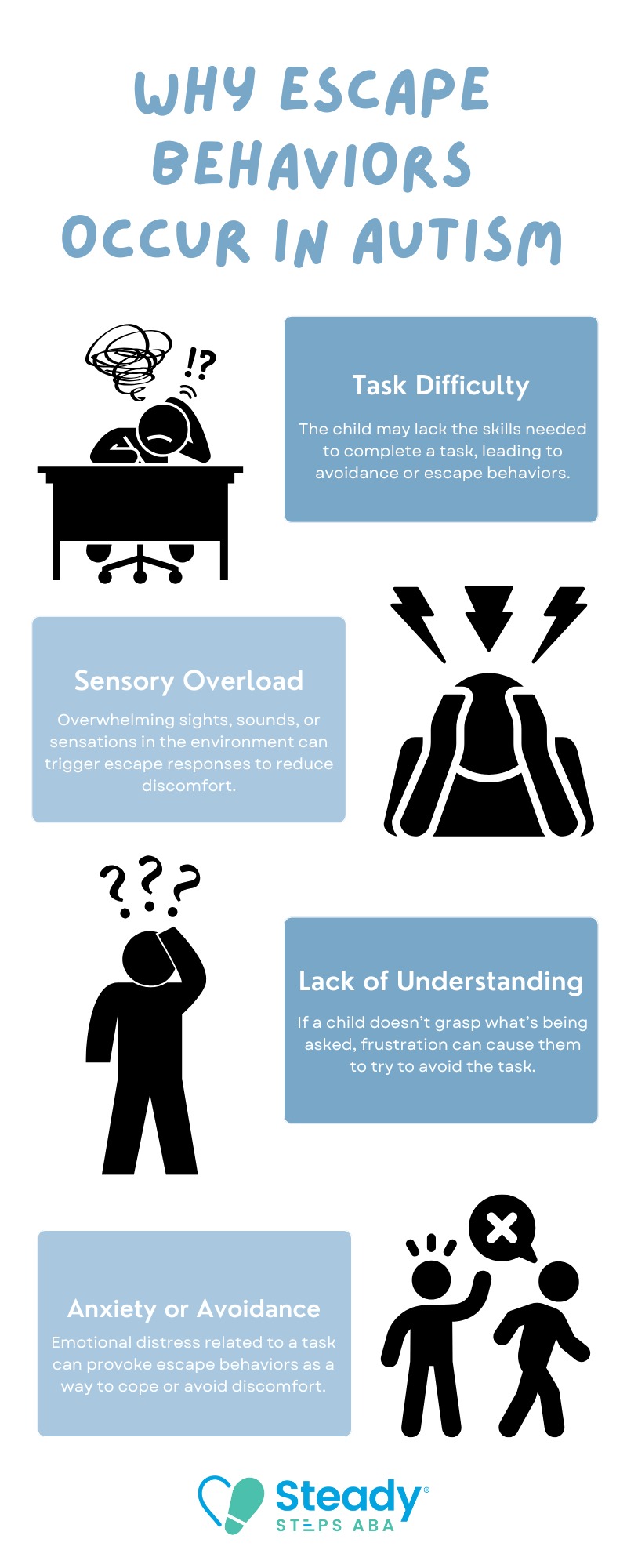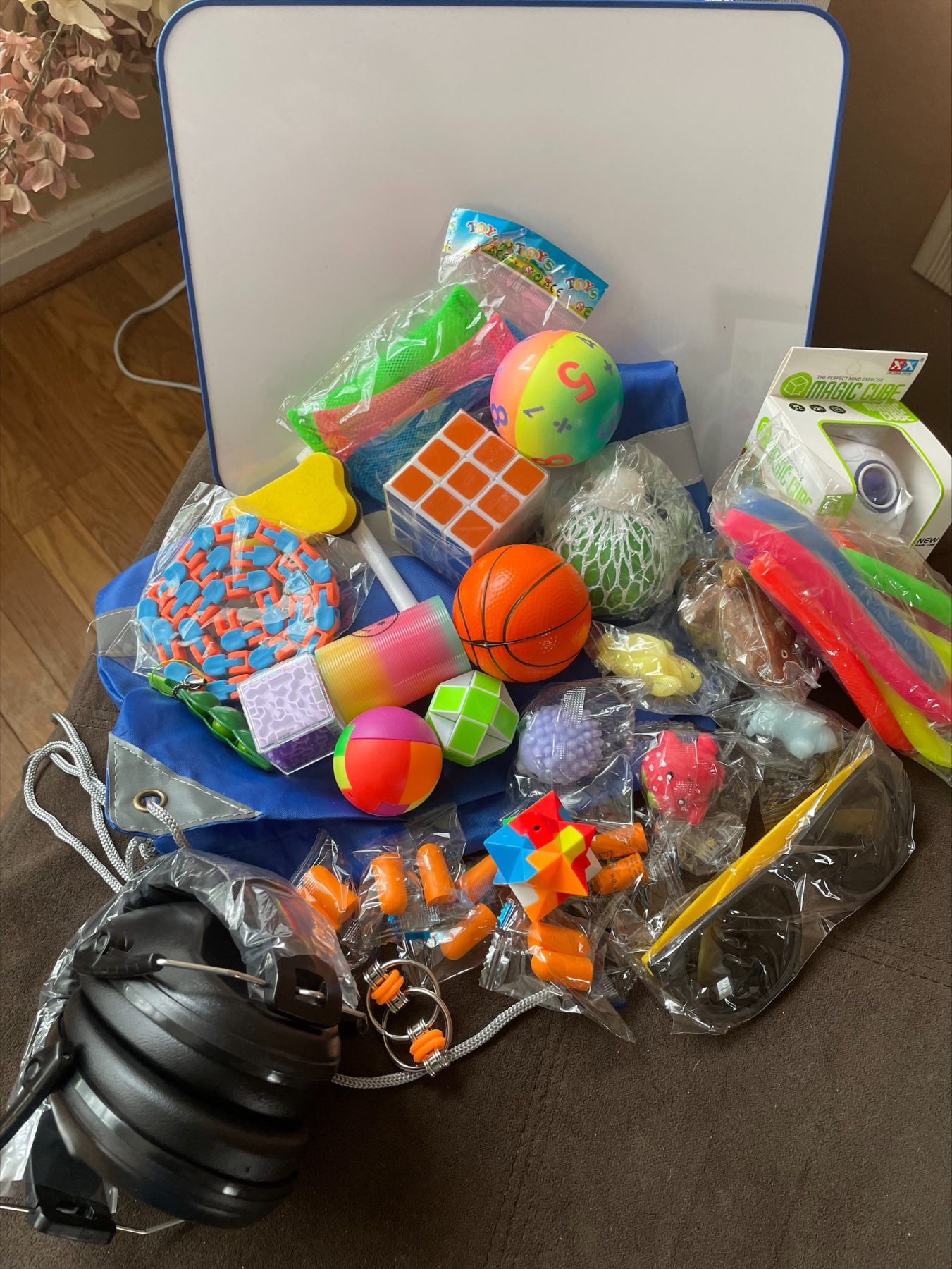Key Points:
- ABA escape behavior occurs when a child tries to avoid or get out of a task, demand, or environment.
- Identifying escape-maintained behaviors is critical to developing effective, individualized interventions.
- Interventions include functional behavior assessments, antecedent strategies, and consistent teaching of alternative behaviors.
Some children with autism exhibit challenging behaviors when they want to avoid a task or situation. These behaviors can include crying, yelling, bolting, or even aggression, which is exhibited in at least 50% of autistic children. These actions are often referred to as ABA escape behaviors, and they are among the most common functions of behavior seen in Applied Behavior Analysis (ABA) therapy.
Understanding the underlying reason for escape behaviors is essential for any parent or caregiver trying to support their child. Without identifying the purpose behind the behavior, it’s difficult to provide meaningful help or prevent escalation. By recognizing the patterns and applying targeted interventions, families can help their children build healthier ways to communicate and cope.
What is Escape Behavior?
Escape behavior refers to any action a child uses to avoid, delay, or get out of a task or situation that they find unpleasant, difficult, or overwhelming. This can include schoolwork, transitions, hygiene routines, or even social interactions. These behaviors are maintained by the consequence of escaping the demand.
For example, if a child throws a tantrum every time it’s time for math, and the task is removed, the behavior is reinforced. Over time, this teaches the child that problem behaviors are effective at avoiding undesired tasks. That’s why escape-maintained behaviors need to be addressed directly and consistently.
Why Do Escape Behaviors Happen?
Children with autism may engage in escape behaviors for a number of reasons, and these vary from child to child. Understanding the why is critical before trying to intervene. A behavior that looks like defiance may actually be rooted in fear, confusion, or skill deficits.
Common reasons include:

When these factors aren’t recognized, interventions might miss the mark—or even make things worse.
How Do You Identify Escape-Maintained Behaviors?
Escape-maintained behaviors occur when a child acts out to avoid or get away from an unpleasant task or situation. To identify these behaviors, observe when they happen—typically during demands or non-preferred activities—and note if the behavior stops once the child is removed from the task.
Functional behavior assessments (FBAs) are often used to pinpoint if escape is the driving factor by systematically analyzing triggers, responses, and consequences. Recognizing escape-maintained behaviors helps guide effective, tailored interventions to teach alternative coping strategies and reduce avoidance—much like understanding how communication functions, such as requests or demands, can influence behavior, as explored in What is Manding in Autism?
What are Examples of Escape Behaviors?
Escape behaviors can range from subtle to extreme. Recognizing the various forms they take is key to choosing the right strategy. These behaviors may not always look disruptive at first glance, which makes them harder to spot without careful observation.
Common examples include:
1. Crying or Whining When Given a Task
Crying or whining can be a child’s way of expressing discomfort or frustration, signaling a desire to avoid or escape a challenging activity.
2. Running Away or Leaving the Area
Physically removing themselves from a task or environment is a clear escape behavior, often used when the child feels overwhelmed or unable to cope.
3. Pretending Not to Hear or Ignoring Instructions
Ignoring directions may seem passive, but it serves as a tactic to delay or avoid completing non-preferred demands or activities.
4. Asking Repeated Questions to Stall
Repeatedly asking questions can function as a stalling technique, buying time to avoid engaging with the task or request.
5. Engaging in Aggressive Behavior
Actions like hitting or biting may occur when a child feels trapped or unable to communicate escape needs effectively.
6. Destroying Materials Related to the Task
Damaging or throwing objects connected to an activity is a more intense form of escape behavior, signaling strong resistance or distress.
Each of these behaviors can serve the same function: to escape or avoid. They often intensify if they are accidentally reinforced.
What are Effective ABA Interventions for Escape Behavior?
Once escape behavior has been confirmed, the next step is intervention. A successful plan should include both proactive (preventative) and reactive (response) strategies. These interventions need to be consistent, individualized, and focused on teaching replacement behaviors.
Examples of interventions include:
1. Modify Task Demands
If the work is too hard or overwhelming, the child is more likely to avoid it. Adjusting the task to meet the child’s current skill level or attention span can prevent escape behaviors before they start.
Modifications may include:
- Breaking down tasks into smaller steps
- Providing visual supports or prompts
- Reducing the length or complexity of assignments
This builds confidence while maintaining expectations.

2. Teach Functional Communication
Many escape behaviors occur because the child doesn’t know how to say, “I need help” or “I need a break.” Teaching children to request breaks appropriately gives them a socially acceptable way to get their needs met.
Helpful replacement skills include:
- Asking for help
- Using visual cards to request a break
- Pointing to emotion icons like “frustrated” or “tired”
When these responses are taught and consistently honored, problem behaviors become less useful.
3. Use Escape Extinction (with Caution)
Escape extinction means not allowing the behavior to produce the escape the child is seeking. For instance, if a child throws their book and you continue the demand it anyway, you’re preventing the behavior from achieving its goal.
Important: This should only be done under the guidance of a trained professional, especially if the behavior is intense or dangerous. Without proper planning and support, it may lead to escalation before it gets better.
Instead of removing the task:
- Pause, prompt a functional communication response, and then resume.
- Offer help, reduce the demand, or break it into parts.
- Reinforce completion with a highly preferred reward.
4. Reinforce Compliance
When a child completes a task—even with support—it should be celebrated. Reinforcement increases the chances that the behavior will happen again in the future.
Ideas for reinforcement include:
- Access to a favorite toy or activity
- Positive praise: “You finished the puzzle even when it was tricky!”
- Sticker charts or point systems
The key is timing: reinforcement should follow quickly after the expected behavior.
5. Use First-Then Schedules
Visual schedules and “first-then” boards help clarify expectations. They show the child that once they complete the less preferred task, something preferred will follow. This provides motivation and structure.
Examples include:
- “First brush teeth, then iPad.”
- “First finish the worksheet, then play outside.”
- “First clean up toys, then watch a show.”
These schedules reduce anxiety and increase follow-through.
How Can Parents Support ABA Escape Behavior Interventions at Home?
Parent involvement is one of the strongest predictors of success in behavior interventions. Consistency across settings—home, school, therapy—is crucial for maintaining gains.
Ways parents can help:
1. Learn the Behavior Plan
Understanding the specific strategies and goals outlined in the ABA plan allows parents to apply interventions correctly and consistently at home.
2. Use the Same Communication Tools
Implementing visuals, break cards, or other tools used in therapy helps the child recognize expectations and supports smoother transitions across environments.
3. Follow Through with Demands
Maintaining consistent expectations—even when the child resists—prevents reinforcing escape behaviors and encourages skill development.
4. Reinforce Positive Behaviors
Providing immediate and regular praise or rewards for appropriate behavior strengthens desired actions and motivates the child to repeat them.
5. Stay Calm and Neutral During Problem Behaviors
Responding calmly to challenging behaviors helps avoid escalating the situation and models emotional regulation for the child.
Collaboration between parents and therapists ensures that strategies are practical, sustainable, and meaningful for the child.
Are Escape Behaviors Always a Problem?
Not necessarily. Asking for a break, walking away from a loud room, or choosing not to engage in an overwhelming task can be healthy and appropriate. The issue is how the child escapes and whether that behavior is harmful or disruptive.
Our goal in ABA is not to eliminate escape but to teach safe, socially appropriate ways to express those needs. When children have tools to advocate for themselves, they don’t have to rely on behavior that puts them or others at risk.
Empowerment—not compliance—is the ultimate goal.
Get the Right Support with ABA Therapy
If your child is engaging in escape behaviors that interfere with learning or family life, Steady Steps ABA can help. We specialize in ABA therapy in Maryland, using evidence-based methods to understand, prevent, and replace escape-maintained behaviors.
Our team works closely with families to create individualized behavior plans focused on communication, independence, and emotional regulation. Through compassionate, structured interventions, we help children thrive, not just comply.
Contact us today to learn how our ABA therapy in Maryland can support your child’s growth, both at home and beyond.






